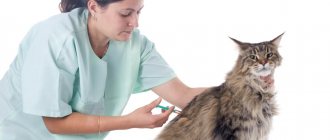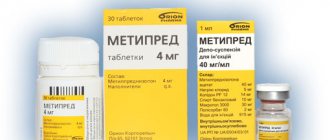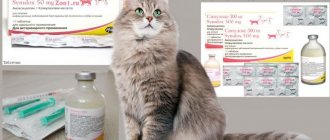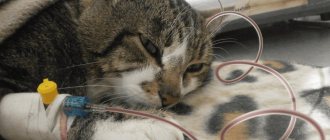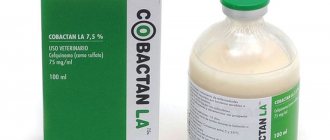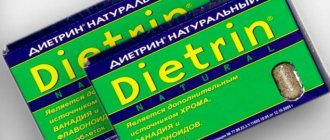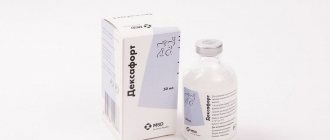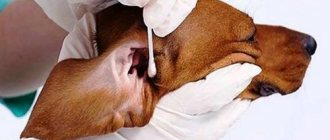An animal's joints and bones naturally break down over time. This can lead to problems with the spine and limbs. A chondroprotector for animals called Artroglycan will help prevent the development of diseases of the musculoskeletal system.
Preface
Dogs, especially large breeds, quite often have problems with the musculoskeletal system: osteoarthritis, discopathy, dysplasia, osteodystrophy, osteochondrodysplasia, discospondylosis and various types of injuries. As a rule, these diseases are characteristic of older animals, as well as those with a breed predisposition to diseases of the musculoskeletal system.
For example, long-bodied and short-legged animals with strongly curled or missing tails (dachshunds, corgis, manchikins, etc.) are predisposed to displaced intervertebral discs. Shar-Peis, Rottweilers, Labradors and Chow Chows are predisposed to joint damage.
Among small breeds, problems with the neck of the femur, which are characterized by necrosis (Lag-Calv-Perthes disease), are common.
Bengals, Scottish Folds, Maine Coons, as well as fast-growing breeds (mastiffs, Great Danes, Malamutes, Alabais, etc.) are predisposed to osteochondrodysplasia.
Among the huge variety of diseases of the musculoskeletal system, the most common and common problem is hip dysplasia. This is a hereditary disease that manifests itself during a period of active growth and weight gain. It can also develop due to poor nutrition and an incorrect ratio of calcium and phosphorus. The main symptom of dysplasia is lameness, pain and reluctance to walk. This disease can be corrected in the early stages with the help of chondroprotectors, in the later stages it can only be eliminated surgically.
Reviews
When our pet was still a kitten, he received an injury to his front paw (his grandmother accidentally pinched it). The baby refused to step on it and had difficulty moving around the apartment. We purchased Artroglycan from a veterinary pharmacy. In the second week of treatment, the veterinarian adjusted the dislocation and advised us to continue giving the drug so that the pet could recover faster. After about a month, our cat began to confidently step on his sore paw, and at the end of the course he finally returned to normal.
Rita
Our Scottish Fold began to limp and reluctantly climb onto her lap, although she previously spent almost all day in her arms. Over time, the cat’s condition only worsened and even got to the point where she practically stopped moving around the house on her own and even ate while lying down. We took her to an appointment with a veterinarian, who, after an examination, discovered osteochondrosis and prescribed Artroglycan. They started giving the cat pills, and her condition began to improve before our eyes. By the end of the course, the lameness disappeared and the pet became active again! The doctor advised us to buy a large package of the drug, because there may be a relapse, and now we always have Artroglycan in our medicine cabinet!
Anna
Recently we noticed that our cat began to actively lick his paws. We read online that this could be a sign of arthritis, and decided to take him to the veterinarian. The diagnosis was confirmed, and the cat was prescribed Artroglycan. They gave the cat pills for several months, then took him for a re-examination. In the picture taken at the veterinary hospital, it was noticeable that the cartilage had strengthened. The doctor advised giving the drug to the animal regularly.
Dmitriy
Our 15 year old cat was diagnosed with osteoporosis.
At the appointment, the specialist recommended giving him Artroglycan. I found the drug to be quite effective and easy to use. Our pet weighs about 10 kg, and we add 1 tablet to his food. After a 3-month course, the cat became much more active. Alexander
What are chondroprotectors?
Chondroprotectors are a group of drugs designed specifically to protect cartilage from subsequent destruction. They are indispensable in the formation and renewal of the cartilage layer on the joints. Chondroprotectors help restore metabolic processes at the site of cartilage damage and at the same time have an anti-inflammatory effect.
As a rule, these types of preparations include chondroitin, glucosamine or collagen hydrolysate. It is also possible to be saturated with certain vitamins, minerals and trace elements.
Release form: tablets, powder, suspension, injections.
When are chondroprotectors prescribed?
The veterinarian prescribes chondroprotectors in the following cases:
- As a preventive measure during pregnancy, in puppyhood, during the active growth phase, during the period of teeth change.
- As a maintenance therapy in adult animals and in breeds prone to dysplasia.
- As a restorative therapy after surgery.
- With a confirmed diagnosis of diseases of the spinal column.
- For joint problems of varying severity.
Dosage
Before using the drug "Artroglycan", you must study the instructions and also calculate the dosage correctly.
The drug is most often used for dogs, so the tablet size exceeds the dose required for a cat. To calculate the optimal amount of active ingredient, refer to the table:
- A single dose for animals from 3 to 4 kilograms is a quarter of a tablet;
- Cats weighing 5 kg should be given half a pill;
- Large breeds 6-7 kg should consume ¾ tablets.
Typically, tablets are given to animals twice a day, however, the individual dosage must be determined by a veterinarian.
The duration of the course should be one month. In some severe cases, therapy is carried out for 2-3 months.
When is artroglycan prescribed?
Artroglycan is a feed additive from the group of chondroprotectors, which compensates for the deficiency of chondroitin and has an anti-inflammatory and analgesic effect. The drug improves metabolic processes in damaged cartilage, normalizes the condition of the osteoarticular system, stabilizes the functioning of the cardiovascular system and liver.
It is prescribed by a veterinarian if the animal begins to limp, experiences discomfort while moving, cannot go down the stairwell, or experiences acute pain when palpating the joints.
Analogues of the drug
If an allergic reaction to Artroglycan is detected in a cat, it can be replaced with similar drugs. The following medications are similar in composition to this drug:
- Felvit Hondro. This veterinary drug is produced in tablet form by a Czech company and is suitable for both adult cats and kittens. It maintains good joint mobility and prevents inflammatory processes in the ligaments.
- Superflex. The drug is available in the form of a liquid supplement, which is especially convenient to give to kittens by adding it to their food. It is an effective chondroprotector for pets, helping them recover faster after surgery and injury.
- Stride plus. A complex anti-inflammatory agent that has an analgesic and antipyretic effect. Available in the form of a liquid food supplement.
- Polegen. The most inexpensive drug aimed at strengthening cartilage. It contains additional components such as zinc and beta-carotene. This vitamin and mineral food supplement also improves the condition of your pet's skin and coat.
Chondroprotectors are also produced in the form of treats. Some of the most famous and effective dietary supplements are Glyco Flex III and Joint Max. The latter is a powder that needs to be mixed into your pet's liquid food.
Composition and pharmacological properties
One tablet of artroglycan contains 700 mg:
- Chondroetin sulfate 200 mg - stops the destruction of bone tissue by blocking the production of special enzymes that have a detrimental effect on cartilage. It also significantly reduces calcium loss and eliminates pain.
- Selenomethionine 50 mg - slows down the aging process, restores tissue elasticity, increases the absorption of chondroitin and glucosamine.
- Glucosamine 100 mg - strengthens cartilage tissue, promotes the synthesis of aminoglycans and stimulates the production of intra-articular fluid.
- Vitamin E 20 mg - antioxidant, normalizes metabolism, improves oxygen consumption by tissues.
- Calcium gluconate 100 mg - has a positive effect on the condition of bone tissue.
Contraindications and side effects
The drug does not cause side effects when used correctly. The only exceptions are those cases when the dosage has been exceeded. The pet exhibited the following symptoms:
- severe itching;
- rashes;
- redness of the skin;
- stool disorder;
- indigestion.
Contraindications to the use of this drug are individual intolerance to one or more components of the drug and the presence of changes in cartilage and bone tissue caused by fungal, bacterial or viral infection.
Indications for use
The drug is recommended for diagnosing the following diseases :
- Hip dysplasia.
- Intervertebral hernia.
- Osteochondrosis.
- Osteoarthritis.
- Osteoporosis.
- Spondylosis.
- Arthritis.
- Arthrosis.
In addition, it is recommended as a prophylactic for degenerative processes of the musculoskeletal system in adult animals, during pregnancy, during lactation, for obesity, during the change of teeth, as well as during the period of active growth of large breed puppies.
How to organize natural nutrition for cats with joint pathologies
If your pet prefers natural food from a very early age, you should adjust its diet taking into account the developed disease. Do not forget that before serving, all products must also be washed or heat treated. Natural nutrition must include:
- Meat (beef, pork), chicken, offal. They can be served boiled or raw (after first freezing to kill possible helminths). It is recommended to cut the meat into small pieces so that the cat can chew comfortably. Remember to remove fat and bone fragments.
- Porridge and cereals. They should be cooked in water or meat broth; using milk is not recommended. Rice, rolled oats, pearl barley, buckwheat, and millet are suitable for feeding cats. Semolina and corn porridge should not be used to feed animals: they contain a lot of empty carbohydrates.
- Boiled vegetables and herbs. These products should be cut into small pieces or crushed into a puree, mixed with meat or porridge. You need to give cats pumpkin, zucchini, carrots, broccoli, and cauliflower. For greens, it is recommended to add parsley, spinach, and lettuce to dishes.
- Dairy products are an essential source of calcium for cats. Milk is indicated only for young animals (up to one year): in more mature ones it is difficult to digest. You can replace it with low-fat cottage cheese, sour cream, fermented baked milk or kefir.
One of my closest friends bought a Munchkin kitten - an adorable baby with short legs. For the first few months, the fluffy was cheerful and affectionate, played a lot and was constantly on the move. However, after just six months, the owner noted that the kitten began to have difficulty climbing onto the sofa and hid from people in the closet most of the time. After a visit to the veterinarian, she was advised to reconsider the furry pet’s diet, switching it to more natural products. Previously, the housewife fed the baby mainly from the table, as a result of which he developed problems with the musculoskeletal system. After talking with the veterinarian, the woman added more fresh meat, natural vegetables and cereals to the kitten’s diet, and completely abandoned sweets and unhealthy treats in the form of sausage and cheese. Within just a few weeks, the furry baby’s behavior has changed significantly: he has become more cheerful and cheerful.
Photo gallery: healthy products for furry pets
Meat without fat is the basis of a cat's diet.
Oatmeal contains healthy carbohydrates
Pumpkin contains many vitamins
Dairy products are rich in calcium and protein
Directions for use and doses
It is given in the recommended dosage twice a day, regardless of meals. As a rule, pets absorb the tablet on their own without any violent methods on the part of the owner.
If the animal refuses to voluntarily take the pill, you can help him. To do this, you need to immobilize him, open his mouth, pressing his fingers on the place where the jaw closes, and then throw the tablet onto the root of the tongue. Next, the mouth closes and rises until the pet makes a swallowing movement.
Instructions for use
The cat should be given the tablets for a month, 2 times a day, mixed with food. If the animal has severe joint pathologies, it is recommended to increase the course to 2-3 months.
The dosage of Artroglycan is calculated based on the weight of the four-legged pet:
- 3−4 kg - a quarter of a tablet;
- no more than 5 kg - half a tablet;
- up to 7 kg - ¾ tablet;
- 10 kg - 1 tablet;
- 15 kg - 1.5 tablets.
The shelf life of Artroglycan for cats is no more than 2 years from the date of manufacture. Opened packaging should be stored in a place protected from sunlight and out of reach of children at a temperature of 0 to +25 degrees. After this time has expired, it is prohibited to use the drug.

